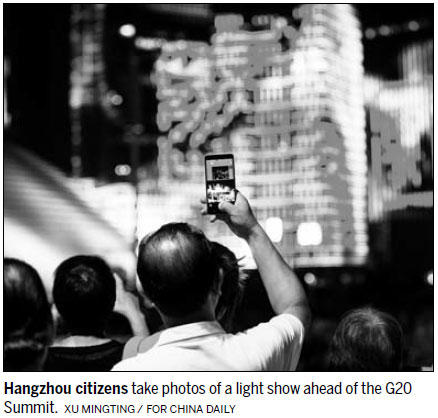Digital billboards light up landscape during G20 Summit
The giant digital billboards that lit up Hangzhou during the recently concluded G20 Summit have been seen as a symbol of China's booming innovative prowess.
The video displays, which are made up of 700,000 LED lights, were installed on more than 30 skyscrapers in the East China city. They featured images of paintings, landscapes and information about the G20 Summit.
"These China-made LEDs consume 50 percent less electricity than traditional lighting," said Shu Xiao, from Hangzhou Urban Management Committee, on Wednesday.
The summit offered Made in China companies the perfect opportunity to showcase some of the nation's exciting projects.
The high-powered silicon substrate-based LED chips, used for the display screens, saw China become the third country, after Japan and the United States, to secure intellectual property rights for blue LEDs, said Chen Zhen, vice-president of LatticePower Corp, which produces the LED chips.
He said the company applied the LED technology developed by Jiang Fengyi, vice-president of Nanchang University, and his research team, and began to mass-produce it in 2012.
The luminous efficiency is equivalent to the sapphire substrate LED technology developed by Japanese firms and silicon carbide substrate-based LEDs developed in the United States.
The China-developed LED has the edge on pricing as it uses cheaper materials, said Chen.
The company, based in East China's Jiangxi province, has developed an industrial cluster to produce the LED screens, with a total annual output value of 5 billion yuan ($763 million).
The LED example is typical of China's innovation-driven economic growth. The government understands that innovation holds the key to unlocking the potential for medium- and long-term growth.
The LED industry has won support from the government of Jiangxi, which issued a blueprint on making the provincial capital, Nanchang, into China's "LED valley" with an annual business revenue of 100 billion yuan by 2020.
Through supporting innovative industries, Jiangxi, which is a comparatively less developed province along China's economic powerhouse, the Yangtze River Delta, recorded the added value of the high-tech industry exceeding 100 billion yuan in the first seven months of 2016. This is up 10.4 percent year-on-year.
In the first half of 2016, the GDP growth rate of Jiangxi was 9.1 percent, fifth-highest out of all the provincial-level economies.

(China Daily 09/14/2016 page17)





 play
play